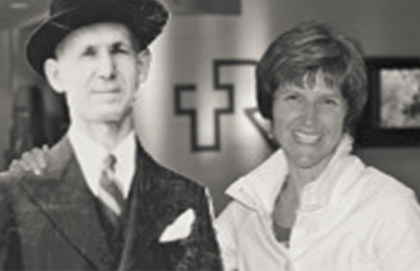I've been on the board of a charity called TREnDS for the past 5 years. Its mission is to equip teens girls to be come smart fashion consumers and to avoid the hypersexual, highly revealing fashions, currently marketed to teens and tweens (10-13 year olds). For most of its existence, TREnDS has been a club-based organization with local chapters delivering weekly or monthly activities for girls in Montreal, Ottawa, Toronto, and Vancouver.
The model is great but for the most part it felt very safe. These girls already agreed the idea that “sex-sells fashion” was a bad thing for women and girls, and wanted to do something about it. What about their peers who were more ambivalent?
In 2017, we were given an amazing opportunity to reach a new kind of audience. We delivered a program for the Sacred Heart School of Montreal. TREnDS would be a theme for the school year, and our activities would be delivered to all 210 students. The challenge, unlike the self-selected group, was that many of these teens loved current fashions, and the stars who promote them. They wouldn't take a critique lying down.
Moreover, through a series of interviews I conducted with the students over the year, I learned they have a philosophy. It’s called: You do you. I also learned these girls live with complex tensions about what it means to be an empowered women and that you do you, in many ways, forces them and their friends to wrestle with those tensions alone.
My goal at Sacred Heart was a change process, getting students to think about contemporary fashion and their own choices in a new light. To be successful I knew I had to meet my audience, and learn their language before the program started! The video project we had integrated into the program served the dual purpose of capturing a snapshot of the experience of the year while gathering intelligence about the girls and how the program was being received. I had 14 keen participants who ranged in age from 12 to 17.
The first questions were easy. What do you like about fashion? Do you have a personal style? The girls enthusiastically expounded on their love of clothes, admiring the style of their older sisters, loving that today you can be unconventional. Some watched YouTube videos to decide what to wear to an event. Others would put an outfit together and then get their mom's opinion (so sweet!). Even though they didn't like all the styles out there, they loved that they could express themselves in a creative way. Then I asked what they didn't like about fashion and that's when things got really interesting.
One 12-year- old said, “I don't like that models have to be thin, and, like, totally perfect. You shouldn't be judged by the size you are.”
A 14- year-old said, “The only thing I don't like about fashion is how people judge what you wear. That can really bring you down.”
Another added, “Like, you can't judge since what they're wearing represents them in a way.”
I dug a bit into the judging issue. Did they judge people? And then it came: “For me, if I see something in the street that's, like, bold, at first I'm, like, 'whoa' but then I’m, like, 'Good for you, like if you're comfortable, you do you.'”
Even though some of the younger students in particular were critical of many today's revealing fashions – specifically finding certain things too short, even “vulgar” - for the most part 'you do you' was what really mattered. They would never want to make a friend feel bad about themselves.
One Grade 11 student, took the point further. She didn't like the false perception that an outfit is sexual, and the presumption that if something is revealing, it is meant to grab the attention of men. It may, she said, just be how the girl likes to dress. I pressed that point: “Is anything objectively sexual?” Answer: No.
If the intention was not to be sexual, then people shouldn't take it as sexual. It is purely subjective. Biology doesn't play a role; only people’s bad assumptions do.
I understood then that if anything I had to say was going to be considered by these girls, it had to be more compelling than this idea that what they choose for themselves is good because they chose it. I also wondered if they were concerned with depictions of women in society since those, too, were all choices.
My second interviews took place after the TREnDS' opening speaker. Things went relatively well with the juniors who had a session for themselves, but were a bit more tense with the seniors. Interestingly there was a split in the class. Many students got up to challenge the speaker while others really liked the presentation. For them, the speaker expressed what they were thinking but felt “scared” to say. At least they were thinking about the issues.
When I met with my interview project seniors, they were friendly and thoughtful, but clear. They had felt talked down to: “She was basically saying you had to dress a certain way to be respected. We know better than that.”
I decided to take the conversation to what really matters: what is going on in society and what it means to them and their peers. Did they feel there were pressures on girls to look or dress in certain ways? Can you really do you? Or are individual senses of style influenced by media, other teens, and social expectations? As part of the discussion I showed the students pictures of girls much younger than themselves, performing in dances and participating in pageants in what can be described only as adult, revealing, outfits. Since the students I was speaking with were about 10 years older than those five and seven year olds in the photos, what messages did they feel the images sent, and what ideas were those younger girls internalizing about themselves? Was it all good?
Although many of the girls did not personally feel pressured to look or dress a certain way, they acknowledged that many of their peers did. Many of their peers seek inspiration for looks, and validation of themselves, through engagement on websites like Instagram. It was not always a good thing. The images of the younger girls dressed and posing in ways that were clearly about flirting bothered them and they felt that this, along with pressures their friends experience, were part of a “sex-sells” trend that is wide-spread in media.
“So is ‘sex-sells’ good, bad, or what?” I asked.
“It's bad,” responded one of the toughest critics of the opening speaker.
“Well, if you think it is bad, why were you upset by the opening speaker criticizing these styles?”
For a moment my interlocutor was stumped, so her friend jumped in.
“I know it sounds like we are contradicting ourselves. Sex-sells is a bad thing and it is not positive that it is promoted the way it is. On the other hand, women should be able to choose what they are comfortable in and not be judged for that.”
There was the real tension. The real feminist does not tell other women how to dress. You do you. On the other hand, it is not good that women's semi-clothed bodies are used to sell everything. But if you are comfortable participating in the style then…you do you.
So, is the message really bad if they choose it themselves? How young is too young to do you?
These very confident, smart and observant girls found themselves in a bit of an idea maze. Just when the path of reasoning was leading to a clear stance, they’d hit another wall in the maze. But it was the same wall: You do you.
The idea that something being a personal choice is what makes it good, struck me as a position with much bigger implications than fashion. These girls could not pursue answers together. Their basic philosophical stance was that you have to find “your truth,” as Oprah would say, and this meant not raising certain concerns with a friend about their choices. Everyone is on her own.
A few months later at the closing presentation where I screened the final video, one girl summed up it: “Look, as long as your morals are intact, you should dress however you want.” Morals, indeed. Is “sex-sells” bad or not? It was the same student.
A few months after the closing session, I was feeling pretty good about the program overall at Sacred Heart. In the workshops we had lots of great discussions about the nature of freedom, about communication and being authentic (as opposed to doing whatever my friends do). Many students, as our closing video attests, felt empowered to be strong confident women, and that was great.
In our workshops, we tried to convey to the girls that doing you involves knowing yourself and using your freedom and talents to uniquely contribute to the world. You are not just something you make up as you go along. You have an identity, talents, friendships and ideas. You are objective, and there are ways to pursue excellence in your appearance, yes, and also in your ability in science or languages, or getting people organized and doing stuff.
Objective identity is something to build from and to honour as you communicate yourself to the world. Seeking integrity between the physical, intellectual, emotional, social and spiritual unity that is each of us is where real strength comes from. The world needs strong girls and women, and strength comes from measuring ourselves against objective standards, meeting and surpassing them, and seeking a new goal takes us to places that you do you never will.
Taking it back to fashion and doing you - we help girls discover another objective truth - which is that the reason all the girls at the dance are wearing the same Lululemon pants and Adidas shoes is because we influence each other, and are influenced by what is elevated in our culture. None of us create our own meanings, including about clothes. Barely-there fashions have a lot more to do with the choices of fashion editors in New York City than those of the girls who buy crop tops. We need to show girls, and all young people, these real forces in our lives and equip them to ask smart questions and to become forces for good themselves.
You do you, says: My judgment about anything is the best there is.
TREnDS says: Let’s talk and think together about what is true about who I am as a person; what is good for girls and women and for society; and what is beautiful?
Convivium means living together. We welcome your voice to the conversation. Do you know someone who would enjoy this article? Send it to them now. Do you have a response to something we've published? Let us know!






